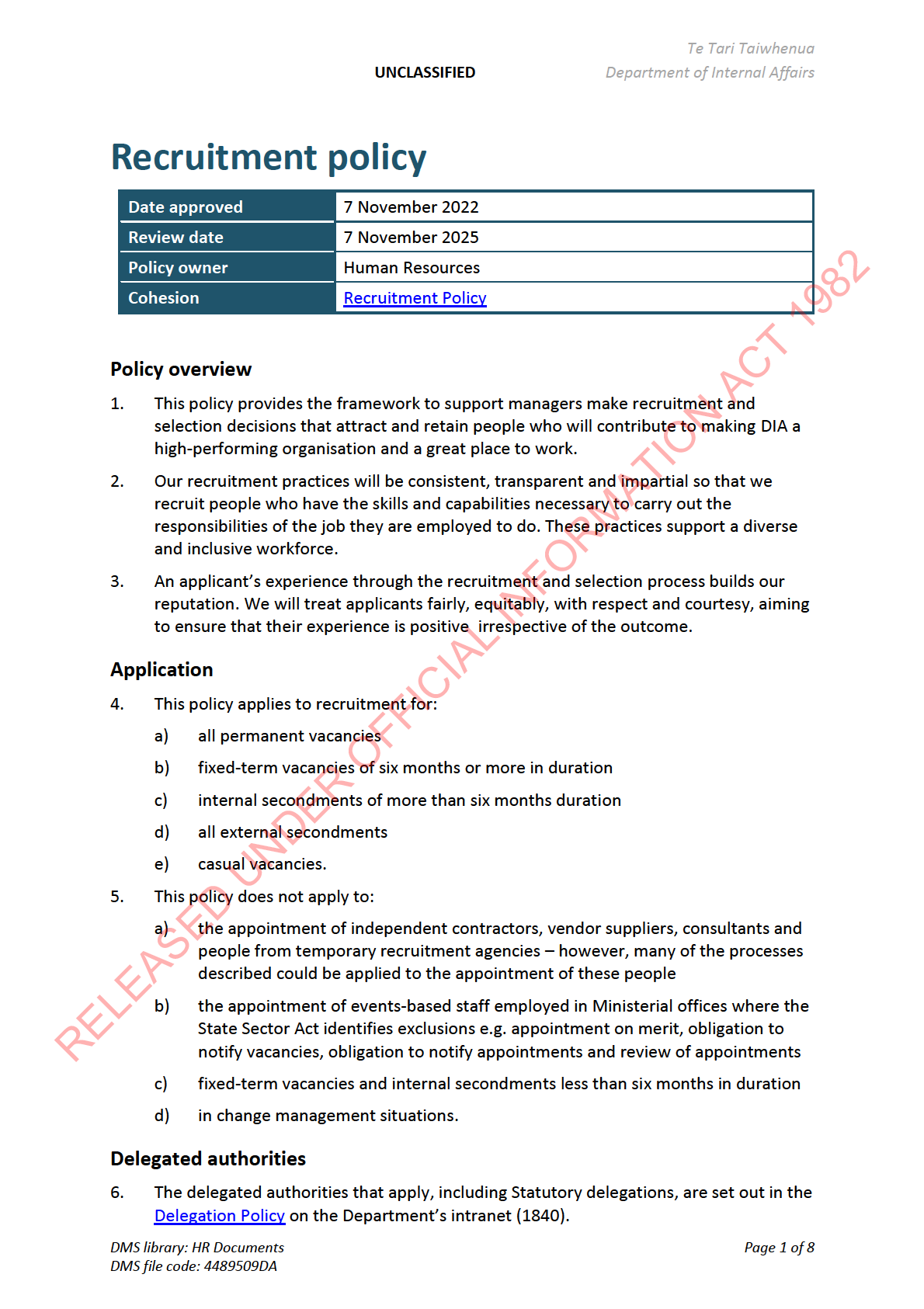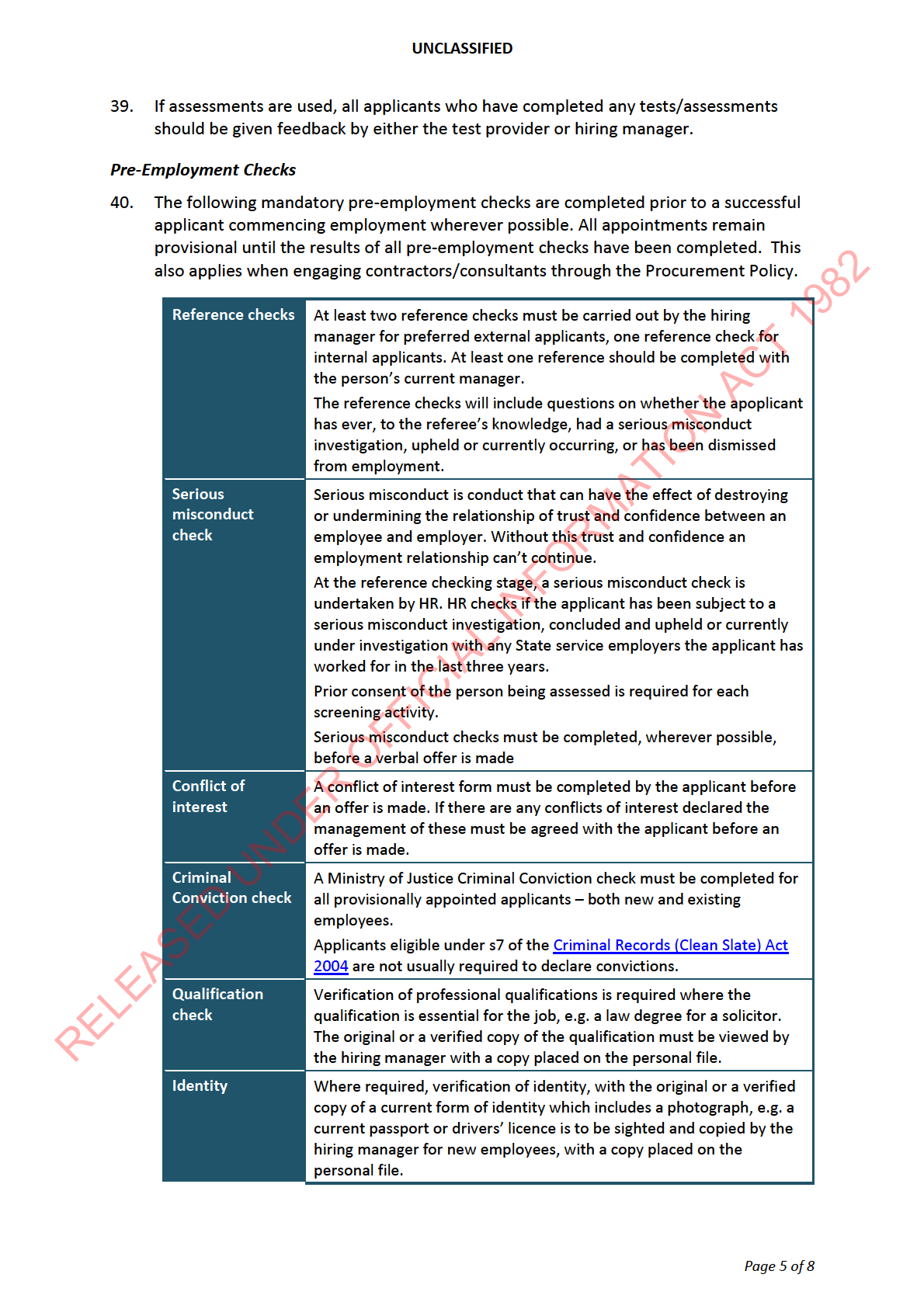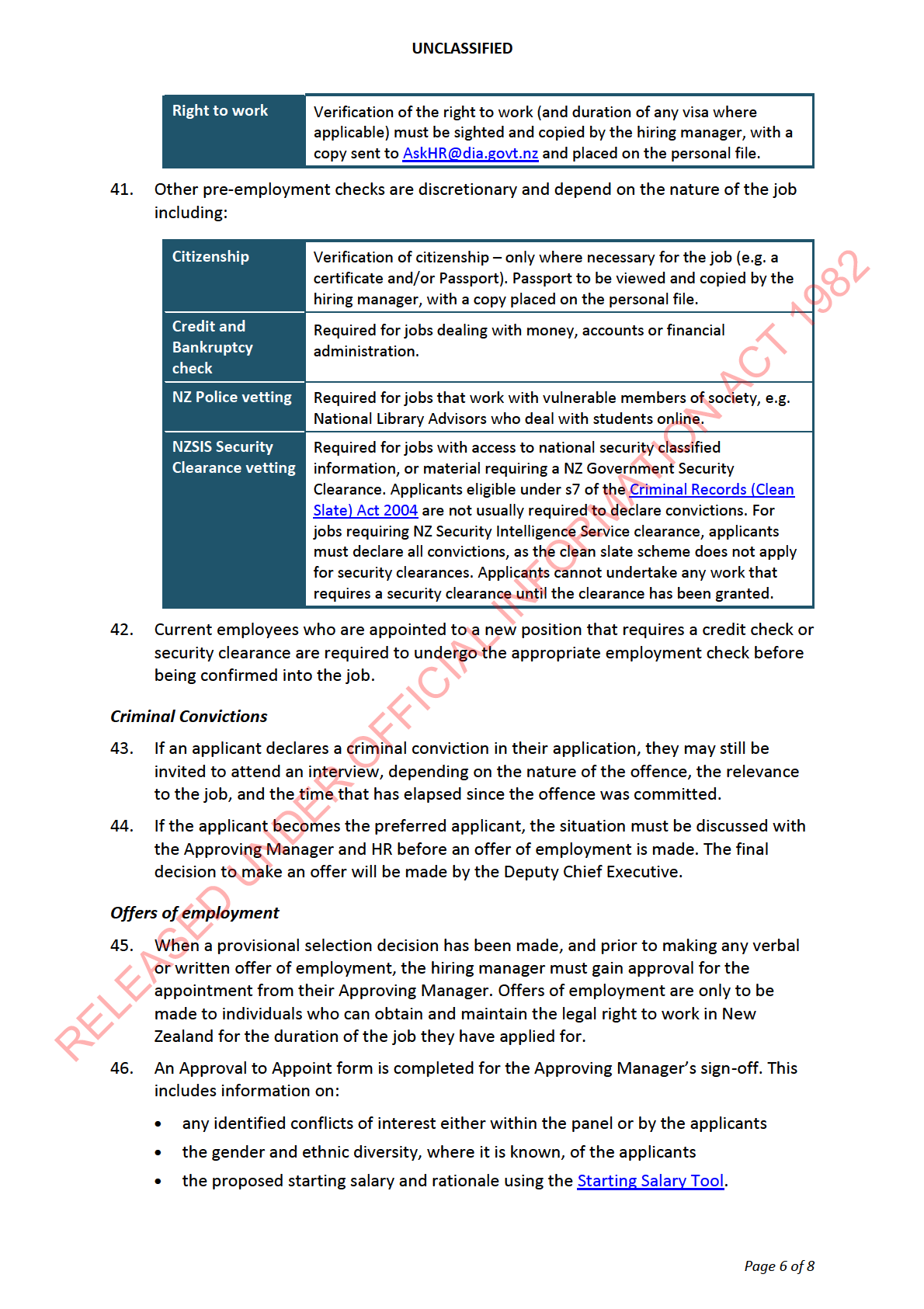


5 May 2023
John Luke
[FYI request #22387 email]
REF: DOIA-2223-0703
Tēnā koe John
Thank you for your email of 5 April 2023 to the Ministry for Ethnic Communities (the
Ministry) requesting the fol owing information under the Official Information Act 1982 (the
OIA).
May I kindly request a full copy of your current recruitment policy and procedure. Also,
are you assessing all application together after the job ad closed?
The Ministry for Ethnic Communities (the Ministry) is a departmental agency of the
Department of Internal Affairs (DIA). As such, the Ministry operates within DIA’s relevant
recruitment related policies and processes. All roles over six-months in duration are required
to be advertised through DIA’s recruitment policy. A copy of the recruitment policy is
enclosed with this response.
In response to the second part of your request, where possible applications will be assessed
as they come in, to ensure applications are processed as soon as possible. Applications are
assessed together in the sense that they are al reviewed under the same criteria.
You have the right to seek an investigation and review by the Ombudsman of our response
to your request. Information about how to contact the Ombudsman’s office is available at:
www.ombudsman.parliament.nz or freephone: 0800 802 602.
Ngā mihi
Edward Firth
Director of Ministerial Services
1

UNCLASSIFIED
Detailed policy
7.
Hiring managers are responsible for planning and managing the recruitment process. If
a hiring manager needs support, they should talk to their manager or contact
[email address].
8.
Appointments are merit-based, giving preference to the person who is best suited to
the position. Merit is not a neutral concept – it reflects the values and beliefs of those
defining it (e.g. diversity and inclusion are elements of merit). Selection decisions are
made using specific selection criteria relevant to the key tasks, person specification
and capabilities required for the job. Applicants will be provided with enough
information to form a clear and accurate understanding of the job they are applying
for and what is required for them to be successful.
9.
Selection decisions must not discriminate (either directly or indirectly) on the basis of
ACT 1982
race, gender, age, sexual orientation, religious belief, ethical belief, colour, ethnic or
national origin, disability, political opinion, employment status, fam ly status or marital
status.
10. The personal information of all people who express an interest in or apply for a
vacancy will be used only for the purpose for which it is collected, disclosed only to
people directly involved in the recruitment process and disposed of when it is no
longer required for the purpose of recruitment (usually three months after the vacancy
has closed).
Link to position management
INFORMATION
11.
Position management is the approach the Department uses to identify, manage and
control the total number of positions that are needed to undertake our core business
and complete specific projects.
12. Recruitment should not commence without a vacant position (either established or
non-established) being available. If there is no position available, the process for
creating a new position should be completed. Position details are found in the
organisational charts on 1840.
Job descriptions and job evaluation
13. The job description outlines what the person doing the job will do, how we know when
they have done it successfully, and the skills, experience, and knowledge (capabilities)
needed to do the job.
14. The job description should be reviewed and an up-to-date job description available
before the recruitment commences. If there is no job description one should be
written – see the Guide: Job descriptions for more information.
15. Job descriptions should be written in plain English, avoiding highly technical terms,
acronyms, jargon and exclusive language, e.g. gendered language.
RELEASED UNDER OFFICIAL
16. If a job description is new or has significantly changed, the job is evaluated before
recruitment commences. Job evaluation is the process of determining the size of a job
and enables the comparison of jobs both internally and externally for salary purposes.
Page 2 of 8
UNCLASSIFIED
Job requisition in Rehutai
17. To commence recruitment the hiring manager completes the job requisition process in
Rehutai. This includes approval from a manager with delegated authority as well as
the HR and Finance Business Partners before recruitment commences. DCE approval is
required for new positions.
Selection panel
18. The hiring manager determines the selection panel. The selection panel should be two
or three people and wherever possible be diverse (both gender and ethnicity) to
minimise biases.
19. The selection panel is involved in all selection activities, such as long-listing, short-
listing, interviews. The panel should remain consistent for all selection activities.
ACT 1982
Selection criteria
20. Selection criteria are the key skills, knowledge, experience, qualifications and
capabilities determined from the job description that a person needs to have to do the
job effectively. Where appropriate this should include the capabilities and outcomes
needed by our leaders identified in the Leadership Success Profile, the leadership
framework for the public sector.
21. Selection criteria should be determined prior to a vacancy being advertised. Wherever
possible the selection criteria should be agreed by the selection panel, signed off by
INFORMATION
the approving manager.
Advertising vacancies
22. Vacancies should be advertised as a minimum internally and externally at the
discretion of the hiring manager.
23. Vacancies of six months or more in duration should be advertised sufficiently to enable
suitably qualified people to apply, wherever practicable.
Using a recruitment agency
24. By exception, where repeated advertising for a vacancy has been unsuccessful or a
vacancy requires a limited specific skill set, it may be appropriate to engage a
recruitment agency to support a manager in searching for suitable candidates.
25. The Department participates in the All-of-Government (AoG) External Recruitment
Services contract managed by the Ministry of Business, Innovation and Employment.
This is a panel of providers who provide recruitment services:
• for permanent, temporary and contractor placements
• for jobs classified within the common administration, common corporate and
common information technology job families
RELEASED UNDER OFFICIAL
• in Auckland, Wellington and Christchurch.
26. Only providers that are on the panel may be used, unless a vacancy falls outside of the
common administration, common corporate or common information technology job
families. To use a provider not on the panel a business case must be written and
approved – see External recruitment services on 1840 for more information.
Page 3 of 8
UNCLASSIFIED
Selection process
27. At least two people should be involved in making selection decisions. Applications are
reviewed independently prior to the panel meeting to discuss.
28. Interview questions are prepared in advance, directly linked to the selection criteria,
ideally using the DIA Recruitment and Selection Tool. All applicants interviewed are
given the same opportunity to present themselves and their capabilities by being
asked the same questions.
29. Interviews are conducted by a panel of two or three people. The panel should remain
consistent for all interviews.
Whānau/support people
30. Applicants are encouraged to bring a whānau/support person(s) with them to an
ACT 1982
interview.
Disability support
31. Where it is appropriate arrangements are made to accommodate applicants with a
disability.
Conflicts of interest
32. Impartial decision-making is crucial for ensuring sound and appropriate selection and
appointment decisions are made. Managing the risk of conflicts of interest in decision-
INFORMATION
makers, including unconscious bias, is a critical part of ensuring impartiality is
achieved.
33. Conflicts of interest declarations must be advised when the hiring manager or a panel
member knows someone who has applied for the vacancy being recruited. This is done
by identifying the conflict on the ‘Shortlisting Summary Form’.
34. The hiring manager or the approving manager (the hiring manager’s manager) will
determine and agree how to manage any conflicts of interest.
35. Applicants are asked to declare any potential conflicts of interest they are aware of
(for example a friend, partner, family or whānau member works at DIA, or they are
known someone with a connection with DIA) by completing the conflicts of interest
question in the online application form.
36. Managers should check the application form for any conflicts of interest and if
identified discuss these with the applicant during any interview.
37. Preferred applicants must complete a conflict of interest declaration form at the time
reference checks are being completed before any offer is made. If any conflicts are
declared the hiring manager must contact the applicant and agree how the conflict will
be managed should the applicant be offered a job at DIA. A conflict of interest should
RELEASED UNDER OFFICIAL
not be a reason for not offering an applicant a job they have applied for.
Psychometric and skills assessments
38. Psychometric and skill assessment tools can provide more information about an
applicant’s potential performance in a job. Any assessments used during the
recruitment process must be relevant to the selection criteria for the vacancy.
Page 4 of 8


UNCLASSIFIED
47. An acceptance of a verbal offer of employment, provisional on the satisfactory
outcome of any outstanding pre-employment checks, constitutes a binding contract
with the Department.
48. A written offer of employment is sent once employment terms have been agreed.
Notification of appointment and review period (promulgation)
49. On return of the signed letter of offer, the provisional appointment to the job will be
notified on 1840. At the hiring manager’s discretion, notification may commence on
receipt of an emailed acceptance from the appointee.
50. All permanent and fixed-term appointments greater than six months in duration must
be notified for a period of seven days (one week).
51. Existing employees have the right to seek a review of a notified appointment within
ACT 1982
seven days of its notification – see the Appointment Review Policy.
52. All appointments remain provisional until the end of the notification period and until
the results of all pre-employment checks have been received. Employees should not
begin in their job until the notification period has ended, or until any appointment
reviews have been resolved.
Secondments
53. Secondments provide opportunities for employees to develop their skills, knowledge
and experience in a supportive learning environment as well as encouraging the
INFORMATION
transfer of skills and working relationships within and across the Department and
other Public Sector agencies. They are a way of resourcing projects and initiatives and
managing skill gaps across the Department.
54. While on secondment the employee retains their substantive position and it is
expected that they will return to this position at the end of the secondment. The
substantive position cannot be filled permanently but may be backfilled.
55. During the secondment, the employee remains on their terms and conditions of
employment. An employee’s remuneration remains unchanged while on secondment.
However, where appropriate a secondment allowance may be paid to acknowledge
any additional responsibilities being undertaken and the skills, experience and
capability of the person to perform the job.
56. If the secondment is to an external organisation, the Department will continue to pay
the employee, recovering the money from the external organisation. The employee
remains an employee of the Department. The reverse applies to secondments into the
Department from an external organisation.
57. Secondments are temporary/acting appointments and are not subject to appointment
review.
RELEASED UNDER OFFICIAL
Relocation/transfer assistance
58. If an employee moves to a new location that is outside their local area (e.g. moves
from Wellington to Auckland) supported by the Department they are deemed to be
relocating.
Page 7 of 8
UNCLASSIFIED
59. An employee’s local area is the town/city/region in which the employee currently
resides. In large urban centres “local area” may include more than one city. For
example, the Wellington region would include Lower Hutt, Upper Hutt and Porirua
cities and extend out to Waikanae/Otaki and Carterton/Masterton areas.
60. Transfer assistance is not usually provided when an employee has instigated the
transfer/relocation, for example where an employee applies for a position outside
their local area. At their discretion a manager may consider providing some transfer
assistance – see the Transfer Assistance Policy for further information.
Documentation
61. Each recruitment process must be appropriately documented to provide a record that
can be used in an appointment review, or if subsequent questions arise about the
appointment.
ACT 1982
62. A Cohesion vacancy folder is created for each vacancy and the hiring manager is
expected to file the Request to Recruit, Approval to Appoint and documents pertinent
to the recruitment process.
63. Documentation associated with each recruitment process must be kept for three
months and then disposed of securely.
Related policies, procedures, standards, guidelines, legislation, and/or
websites
INFORMATION
64. The following supporting resources are relevant to this policy:
• Guide: Job descriptions
• Job Evaluation Policy
• External recruitment services on 1840
• DIA Recruitment and Selection Tool
• Appointment Review Policy
• Transfer Assistance Policy
• Recruitment guide: Prepare
• Recruitment guide: Attract
• Recruitment guide: Select
• Recruitment guide: Offer
RELEASED UNDER OFFICIAL
Page 8 of 8
Document Outline





